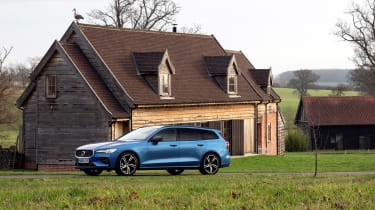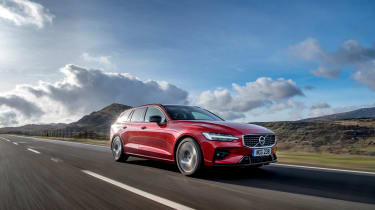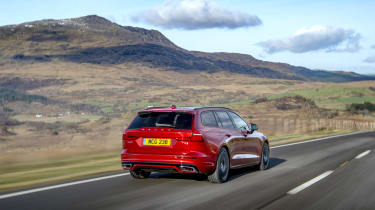2019 Volvo V60 review - is the new V60 estate the best of its kind? - Ride and handling
Volvo’s latest V60 is a brilliant estate car, but rather less entertaining to drive than it could be
The V60 sits on the firm’s Scalable Product Architecture (SPA) platform, which has been designed with future electrification in mind (from 2020 all new Volvo products will be electrified to some degree).
Suspension is double wishbones up front and multi-link at the rear, with the rear also using a transverse composite leaf spring for packaging and weight benefits. Adaptive damping is available, and R-Design models, available later down the line, will get a sports suspension set-up.
From the moment you twist the knurled starter knob and pull away, the V60’s mission is clear: this is a car to soothe rather than excite. Noise and vibrations from the engine are kept to a minimum, the controls are fluid but light, and the ride is absorbent regardless of trim level, suspension or wheel choices.
And to be clear, that’s not a criticism. There’ll be a Polestar Engineered variant of the V60 along in due course with higher performance and a more engaging chassis to take the fight to hotter German rivals, but in the meantime the V60 is a compelling alternative to the less exciting versions of A4 Avants, 3-series Tourings and C-class estates.
For one, the cabin is tastefully appointed, well-constructed, quiet, and as we’ve come to expect from Volvos, the seats are among the best on the market for spending hours in at a time, aided by a wide range of adjustment for the seats and steering wheel. Neither the TFT display nor the infotainment set-up are quite the best in class (Audi probably takes the edge here thanks to its Virtual Cockpit option) but you do get a head-up display and with more familiarity the unusual portrait touchscreen should be easy enough to fathom.
Out on the road you’re struck by the light controls, with a featherweight feel to the throttle pedal, strong but relatively soft brakes, and friction-free (and feedback-free) steering. It’s certainly not a car that encourages you to press on from the outset, even when the driving mode switch is rotated to Dynamic and you’re granted extra steering weight, better throttle response and (on some models) firmer damping, not least because the step up from Comfort feels relatively small.
However, the chassis can cope with harder driving, and while body control isn’t quite in the same league as those German alternatives can manage – the V60 takes a moment to compose itself over undulations and in quick changes of direction – the trade-off is a ride quality that betters any of those, feeling long-legged on the motorway and cosseting on more broken surfaces.
Importantly, it does feel like a good basis for an eventual performance model, with a solid feel to the structure and no glaring flaws in its dynamics. For the time being, it’s simply a refined, comfortable and handsome family wagon – and infinitely preferable to any of the crossovers you might consider as alternatives.





